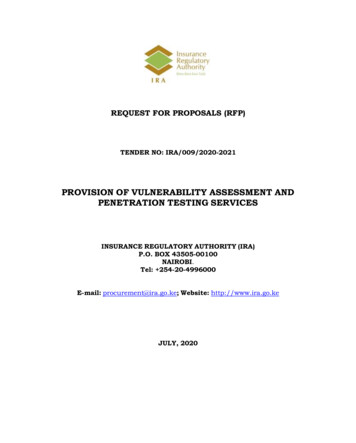
Transcription
Human Settlements Discussion Paper SeriesTheme: Water-1PRIVATIZATION AND THE PROVISION OF URBAN WATER ANDSANITATION IN AFRICA, ASIA AND LATIN AMERICABYJESSICA BUDDS AND GORDON MCGRANAHAN2003ISBN: 1 84369 494 8http://www.iied.org/urban/documents/water dp1.pdfInternational Institute for Environment and Development (IIED)3 Endsleigh Street, London WC1H 0DD, United KingdomTel: (44) 020 7388 2117Email: Humansett@iied.orgWebsite:www.iied.org
PRIVATIZATION AND THE PROVISION OF URBAN WATER AND SANITATIONIN AFRICA, ASIA AND LATIN AMERICAJESSICA BUDDS AND GORDON MCGRANAHANJessica Budds is a doctoral candidate in the School of Geography and the Environment at theUniversity of Oxford, working on water privatization and water markets in Chile.Address: School of Geography and the Environment, Mansfield Road, Oxford, OX1 3TB,United Kingdom; e-mail: jessica.budds@geog.ox.ac.ukGordon McGranahan is Director of the Human Settlements Programme at IIED.Address: International Institute for Environment and Development, 3 Endsleigh Street,London, WC1H 0DD, United Kingdom; e-mail: gordon.mcgranahan@iied.orgAcknowledgementsThe authors would like to thank David Johnstone (independent water and sewerageconsultant), who generously gave his time to be interviewed for this paper; David Hall(Director, Public Services International Research Unit, University of Greenwich), whoassisted with data on the global scale of privatization; and Diana Mitlin (IIED and Universityof Manchester), who provided materials and background notes. Helpful comments weregratefully received from David Johnstone, David Hall and Andrei Jouravlev (United NationsEconomic Commission for Latin America and the Caribbean). An earlier version of this paperwas prepared as a background paper for a UN–HABITAT book on Water and Sanitation inthe World’s Cities (see note 2). Financial support from the Swedish InternationalDevelopment Co-operation Agency and the Royal Danish Ministry of Foreign Affairs(DANIDA) is also gratefully acknowledged. The views presented in the paper are, however,those of the authors alone.1
Executive summaryAlthough private sector participation was probably the most vigorously promoted policyagenda in the water sector during the 1990s, it was and remains very controversial. Thisworking paper re-examines the strategy of increasing private sector participation in thecontext of the recent water and sanitation targets. It looks first at the continuing debates, thenat some of the key practical issues, and finally at the changing nature and extent of privatesector participation in the water sector, all with an emphasis on those parts of the world wherethe water and sanitation targets imply that major improvements must be made. The conclusionis that promoting private sector participation – at least as it has been pursued to date – is notgoing to help ensure that the water and sanitation targets are met, and may detract attentionfrom the more important changes that are needed, as well as the locations where thesechanges must be made.There is general agreement that the rate at which public utilities have been extending access towater and sanitation in deprived areas has been too slow, and that public utilities are ofteninefficient and at times corrupt. The notion that increasing private sector involvement is theway to address these problems is contentious, however. There is room for genuinedisagreement over whether the best response to a failing public utility is to bring in the privatesector, or whether it is better to reform the public utility and its regulation, or to encouragecivil society and community groups to play a greater role. But what makes the conflictbetween privatization and its alternatives so contentious is that while the debate is ostensiblyabout matters of high public interest, the different positions are also associated with lesselevated vested interests, such as the profits of water operators and the jobs of public sectorworkers.There are a number of reasons why this paper is pessimistic about the role that privatizationcan be expected to play in achieving the water and sanitation targets that were agreed upon atthe Millennium Summit and the World Summit for Sustainable Development of reducing byhalf the number of people without sustainable access to safe drinking water and basicsanitation between 2000 and 2015. Many of the underlying obstacles to service provision inthe settlements to be targeted, including severe income poverty, disputed land tenure, publicfinancial crises, and political corruption and cronyism, can persist whether the water andsanitation utilities are publicly or privately operated. There is little evidence that privateoperators are interested in investing in the economically deprived settlements andneighbourhoods where those without adequate water and sanitation actually live. Moreover,private sector participation can bring its own problems, especially if it is imposed from theoutside.The private versus public debate is often polemical. Proponents of privatization will claimthat public utilities are inherently inefficient, overstaffed, manipulated by politicians to serveshort-term political ends, unresponsive to consumer demands, and – particularly in lowincome settings – inclined to provide subsidized services to the urban middle class and leavethe urban and rural poor unserved. Opponents will claim that private operators put privateprofits above the public interest, exploit their monopoly positions, ignore the public healthconsequences of inadequate water and sanitation, and manipulate politicians to help achievetheir economic ends. Unfortunately, such arguments not only ignore the variety of rolesprivate enterprises can play in water and sanitation utilities, and the variety of contexts inwhich they play these roles, but more importantly, a focus on the roles of the private andpublic sector tends to detract attention from those problems that have nothing to do withprivatization, however defined. Moreover, in debating the purported strengths and weaknesses2
of private and public sector actors, it is easy to lose sight of how the process of privatization isactually unfolding.Despite its prominence in recent debates and policies in the water sector, increasing privatesector participation has achieved neither the scale nor the benefits anticipated. Only aroundfive per cent of the world’s population is currently estimated to be served by formal privateproviders. Privatization in water and sanitation provision increased significantly in Africa,Asia and Latin America during the 1990s, but has since declined. Within these regions,private sector participation and investment in the water sector is concentrated in thosecountries with larger economies and populations and higher levels of urbanization, that is,Latin America and South East Asia, with mostly short-term initiatives in Africa and elsewherein Asia. The private water and sewerage market is also dominated by a small number ofmultinational water companies. The level of foreign private finance has been low, with mostfinance coming from the public sector, multilateral loans and user charges. Low-incomegroups are often too poor and risky to represent attractive customers, and the settlements mostin need of improvements in water and sanitation – especially peripheral and untenuredsettlements – tend to be those most likely to be excluded from contracts. Although there havebeen a few pilot initiatives by private operators designed specifically to serve low-incomeareas, most of these have had to be tailored to their locations, and are not easily replicable.Moreover, among the “pro-poor” measures commonly recommended to private utilities, manyare equally relevant to public utilities.Experience suggests that the lowest-income groups, with the least access to water andsanitation services, receive the fewest benefits from private provision. This is not because ofsome inherent contradiction between private profits and the public good. It is because, as theyare currently regulated, neither publicly nor privately operated utilities are well suited toserving the majority of low-income households who currently lack adequate water orsanitation. This is not to say that local governments should not choose to involve privatecompanies in water and sanitation provision. But it does imply that privatization should not bepromoted internationally, as if it provides a key to achieving the water and sanitation targetswithin the Millennium Development Goals.3
Table of contentsAcknowledgements. 1Executive summary. 2INTRODUCTION . 5A note on definitions . 61.PUBLIC VERSUS PRIVATE PROVISION: CONTINUING DEBATES. 81.1Background of public and private management of water and sanitation services . 81.2The arguments for public or private provision of water and sanitation . 101.2.1Public goods . 101.2.2Natural monopolies . 111.2.3Human rights . 121.2.4Economic goods . 131.2.5State failure and private sector efficiency . 152.PRIVATE SECTOR PARTICIPATION IN PRACTICE: KEY ISSUES . 182.1Forms of private sector participation in water and sanitation utilities . 182.1.1Service contract . 192.1.2Management contract . 192.1.3Affermage contract. 192.1.4Lease contract. 192.1.5Concession contract. 192.1.6BOT (Build, Own, Transfer)-type contract. 202.1.7Divestiture . 202.1.8Joint ventures, public water PLCs and co-operative models . 202.1.9Multi-utility contract . 212.2Public sector drivers to involve private enterprises . 212.3Private sector drivers to engage in the water sector . 222.4The bidding process and renegotiation. 222.5Finance and financial risk . 242.6Pricing and tariffs . 262.7Competition and monopoly power. 282.8Other regulatory issues. 292.9Private sector provision to low-income groups. 313.THE CHANGING GLOBAL SCALE AND NATURE OF PRIVATE SECTOR PARTICIPATION INTHE WATER SECTOR . 353.1Trends in the water and sanitation sector . 353.2The extent of private sector participation in the sector in the South. 393.2.1Sub-Saharan Africa . 393.2.2Middle East and North Africa . 413.2.3South Asia . 423.2.4South East Asia and China . 423.2.5Latin America and the Caribbean. 434.CONCLUSIONS . 464
INTRODUCTIONPrivate sector participation was promoted heavily in the 1990s as a means of achievinggreater efficiency and coverage in the water and sanitation sector. It can be situated broadlywithin the set of “neoliberal” reforms, which emphasize the roles of free markets and theprivate sector in economic development, and advocate a limited facilitating and regulatoryrole for the state. In the water sector, neoliberal reformers have emphasized the economicaspects of water resources and their management. The reforms themselves have often beendriven by multilateral financial institutions, with the support of bilateral developmentagencies. In effect, they were accepted by a large part of the development establishment, evenin the face of considerable resistance.Private sector participation in water and sanitation provision increased significantly in manycountries in Latin America, Asia and Africa during the 1990s. Increasing private sectorparticipation in water and sanitation utilities has been the most controversial approach toimproving provision in recent years. Private sector participation presents both obstacles to andopportunities for improving water and sanitation provision in low-income urban areas, withthe outcomes largely depending on how it is implemented in different local contexts. Underthe right circumstances, private sector participation can improve efficiency and increase thefinancial resources available for improving water and sanitation services. However, it can alsodirect finance to urban centres and neighbourhoods that are already comparatively wellserved, lead to significant tariff increases, further polarize the politics of water and sanitation,and create new regulatory problems.It should be noted at the outset that few of the people identified through the water andsanitation targets are likely to be served in the foreseeable future by the conventional waterand sewerage networks that the private water companies (and most public utilities) are used tooperating. The recent Global Water Supply and Sanitation Assessment estimated that 1.1billion poor people still lack reasonable access to improved drinking water supplies and 2.4billion lack reasonable access to improved sanitation.1 More than 80 per cent of these 1.1 and2.4 billion “unserved” live in rural areas. As indicated in a recent UN–Habitat report (forwhich an earlier version of this paper was submitted as a background paper), the number ofurban dwellers without adequate water and sanitation services is probably far higher thanthese figures imply.2 But even the unserved urban dwellers tend to live in the smaller, lowincome towns and cities, or low-income areas neighbourhoods within large cities, which thelarge water companies have shown little interest in serving. In short, to the extent that theprivatization debate focuses on large cities with substantial middle classes, it is not veryrelevant to the water and sanitation targets.This working paper aims to explore the privatization debate, cover the key issues arising frompractice, outline current trends in the sector and, lastly, gauge the extent of private sectorprovision of water and sanitation services in the South. Section 1 reviews the polemic debatesurrounding private sector participation in water and sanitation services, with particularreference to arguments mobilized for and against its implementation in the South. Section 2covers some of the key issues arising from the implementation of private provision, includingits implications for low-income groups. Section 3 gives an overview of recent trends inprivate sector participation, including regional developments in Africa, Asia and LatinAmerica, and the final section brings together the key points by way of conclusion.5
A note on definitionsWhile terms such as “private sector participation”, “privatization” and “Public–PrivatePartnership” (PPP) are in common use, there is sufficient ambiguity to justify noting some ofthe different ways in which they are used in the literature. At the end of this section, there is abrief note on how the terms will be used for the remainder of the paper.Generally speaking, the term “private sector” is used to refer to formal and profit-makingenterprises, but can also denote any organization that is not public (i.e. government-ownedand managed). In the context of private sector participation in the water sector, the focus isalmost entirely on formal water companies, usually large, commercial and multinational.3However, small-scale and/or informal operators are increasingly being recognized anddescribed as private enterprises.4 Furthermore, civil society organizations are also sometimesviewed as part of the private sector where they engage in the provision of water and sanitationservices, often on a small scale and to low-income settlements.5 Informal operators and civilsociety organizations are both very different types of organization from large watercompanies, typically play very different roles, and often operate on very different principles(most civil society organizations, for example, have no shareholders and operate on a not-forprofit basis). Similarly, “private sector participation” could also be used to cover a wide rangeof arrangements but, in the water sector, usually refers to the involvement of formal privatecompanies in a contractual agreement with a public agency.The term “privatization” is widely used in the literature, but can be used to refer to two ratherdifferent things. On the one hand, “privatization” is sometimes used as a generic term to referto increasing private sector involvement; and on the other hand, it is used to refer specificallyto the model of divestiture or “full privatization” wherein the water system is transferred toprivate ownership (see section 2.1.7).The term “Public–Private Partnership” (PPP) is also widely used, but is rarely defined. It issometimes used to refer to the range of situations where a public agency works with one ormore private enterprises to provide goods or services. Alternatively, it can be used to refer tothe narrower range of situations where the public and private parties agree to engage in along-term relationship and invest in a common enterprise. In the water and sanitation sector, itactually tends to be used to refer to contractual arrangements wherein private companiesassume greater responsibility and/or risk, especially through concession contracts (see section2.1.5).6 In such cases, the use of the term partnership may be meant to imply that the partiesinvolved have mutually shared objectives and working arrangements that go beyond thefulfilment of any contractual agreement.7In an attempt to provide more precise terminology, Bakker uses the wider term“marketization” to signify the introduction of the logic of the market into water resourcesmanagement and/or water supply, a process which includes “privatization” (the shift inownership and control from the public to private companies with private capital) and“commercialization” (a reworking of water management institutions along commercial lines,but not necessarily with private sector involvement).8 This last concept is referred toelsewhere as “corporatization”.9 As this extended terminology indicates, just as some privatesector enterprises do not really conform to the conventional firm envisaged in discussions ofprivate sector participation and markets, there are times when the behaviour of public utilitiesdoes seem to conform, at least to a degree.For the purposes of this working paper, “privatization” refers to processes that increase theparticipation of formal private enterprises in water and sanitation provision, but do notnecessarily involve the transfer of assets to the private sector. Unless otherwise noted,references to “private sector participation” also refer to formal private enterprises operating6
for or with water utilities. The term “Public–Private Partnership” is not used in this paper, onthe grounds that it can imply shared objectives that do not exist. Small-scale and informaloperators and civil society organizations are not given much attention because they are notconsidered to be within the private sector scope of this paper – it is not that they areconsidered unimportant.7
1.PUBLIC VERSUS PRIVATE PROVISION: CONTINUING DEBATESThe degree of private sector participation in different utility sectors, of which the water andsanitation sector is just one, has increased significantly since the 1980s, especially so between1990 and 2000. The expansion of private sector involvement in water and sanitation provisionhas been more controversial than in other utility sectors, and this is especially so in the South,where there are concerns that private sector involvement has been undertaken in response toNorthern pressure rather than through a locally driven political process. This section willsummarize the debate and the issues arising from private sector participation in water andsanitation services, with a focus on urban centres in low- and middle-income countries whereservices are often absent or inadequate.1.1Background of public and private management of water and sanitationservicesOver the course of the nineteenth century, water and sanitation emerged as a major publicissue in the industrializing cities of Europe and North America. The first water and sanitationservices were, in fact, provided by the private sector, but restricted to the wealthier socialgroups who were able and willing to pay for them. At the time, these cities comprised largenumbers of poor urban dwellers who lived in overcrowded conditions with no sanitation. Theresulting environmental diseases, such as cholera and typhoid, led to high urban death rates,which, moreover, affected all urban groups and not just those actually living in squalidconditions. Although private participation was also widely debated in the nineteenth century,and the free market viewpoint was very prevalent in many of the countries undergoingsanitary reform, governments became convinced that water was important for both publichealth and national economic development. For these and other reasons, governmentsincreasingly assumed the task of installing and managing piped water and water-bornesewerage systems, with the goal of universal provision.During the twentieth century, these efforts were institutionalized in cities around the world,and water and sewerage services have been managed almost exclusively by the public sector.However, provision in Africa, Asia and Latin America significantly lagged behind progress inthe North. The 1980s were designated the International Drinking Water and SanitationDecade, in an attempt to prioritize and accelerate provision throughout the South. By the endof the Decade, while the targets set were still far from met, a new consensus appeared to beemerging among a number of international actors within the water sector. Despite theexperiences of the previous century, private sector participation in water and sanitation againstarted to be promoted to address deficiencies in water and sanitation infrastructure andservices in the South.The move back towards private provision can be explained as a result of the shift away fromstatist and towards neoliberal (free market) policies in the North from the late 1970s. Whilestatist ideology holds that society’s needs and problems are best addressed by the statethrough the political process, the neoliberal doctrine believes that social functions andeconomic development should be undertaken by business, with the state playing a facilitatingand regulatory role without direct engagement. The neoliberal agenda was simultaneouslyadopted by the North-dominated international financial institutions (primarily the World BankGroup and the International Monetary Fund), which, using their leverage as creditors,aggressively promoted neoliberal reforms to governments of indebted low- and middleincome countries, often through structural adjustment policies that advocated the reduction ofstate spending and avoidance of substantial state investment.108
Neoliberal ideas had a profound influence on international development and policy debates inthe water sector in the 1990s. The 1992 “Dublin Principles” illustrate this new perspective,and are reproduced in Box 1. These four principles apply four development dicta of the 1990sto the water sector: care for the environment, increased participation of non-governmentalstakeholders, sensitivity to gender issues, and increased role of markets. In this sense, they areunexceptional, even if, as in the broader development arena, it remains far from clear howsuch principles are to be combined and implemented, and whether they are really supportedby a broad-based consensus. What is striking, however, is that the need to treat water as afinite and vulnerable resource is explicit in the first principle, while the need to ensureadequate water and sanitation provision is embedded in a principle relating to the treatment ofwater as an economic good. In the wake of Dublin, many international organizationsrealigned their position in the water sector, and a series of new water sector organizations andinstitutions emerged.11 The World Bank came to play a central role in developing andpromoting new approaches consistent with its interpretation of the Dublin Principles, and inparticular the treatment of water as an economic good. International financial institutionspackaged reforms in the water sector with wider neoliberal policies, often through StructuralAdjustment Programmes. The way was thus opened for the privatization of water utilities incities in Latin America, Asia and Africa.Box 1: The Dublin Principles1. Freshwater is a finite and vulnerable resource, essential to sustain life, development and theenvironmentSince water sustains life, effective management of water resources demands a holistic approach, linking socialand economic development with protection of natural ecosystems. Effective management links land and wateruses across the whole of a catchment area or aquifer.2. Water development and management should be based on a participatory approach, involving users,planners and policy makers at all levelsThe participatory approach involves raising awareness of the importance of water among policy makers and thegeneral public. It means that decisions are taken at the lowest appropriate level, with full public consultation, andwith the involvement of the users in the planning and implementation of projects.3. Women play a central part in the provision, management and safeguarding of waterThe pivotal role of women as providers and users of water, and guardians of the living environment has seldombeen reflected in institutional arrangements for the development and management of water resources.Acceptance and implementation of this principle requires positive policies to address women’s specific needsand to equip and empower women to participate at all levels in water resources programmes, including decisionmaking and implementation, in ways defined by them.4. Water has an economic value in all its competing uses and should be recognized as an economic goodWithin this principle, it is vital to recognize first the basic right of all human beings to have access to clean waterand sanitation at an affordable price. Past failure to recognize the economic value of water has led to wastefuland environmentally damaging uses of the resource. Managing water as an economic good is an important wayof achieving efficient and equitable use, and of encouraging conservation and protection of water resources.SOURCE: WMO (1992), International Conference on Water and the Environment: Development Issues for the21st Century: The Dublin Statement and Report of the Conference, World Meteorological Organization, Geneva.At the Millennium Summit in September 2000, the states of the United Nations agreed on aset of Millennium Development Goals. One of the specific targets identified was to halve theproportion of people without sustainable access to safe drinking water by 2015. At the World9
Summit on Sustainable Development in September 2002, another relevant target was set:halving the proportion of people without access to basic sanitation by 2015.121.2The arguments for public or private provision of water and sanitationIn debating whether water and sanitation should be provided by the public sector, the privatesector or through collaborative arrangements, numerous attempts have been made to arguethat, given the innate characteristics
JESSICA BUDDS AND GORDON MCGRANAHAN Jessica Budds is a doctoral candidate in the School of Geography and the Environment at the University of Oxford, working on water privatization and water markets in Chile. Address: School of Geography and the Environment, Mansfield Road, Oxford, OX1 3TB, United Kingdom; e-mail: jessica.budds@geog.ox.ac.uk










